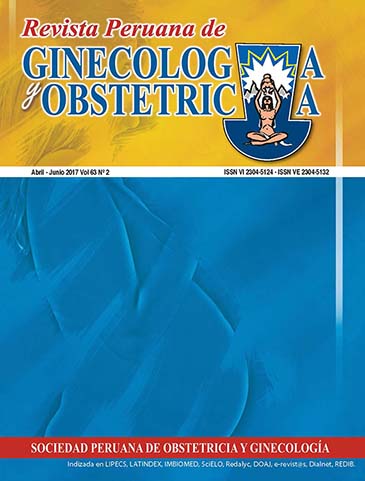Acute renal injury in women with HELLP syndrome
DOI:
https://doi.org/10.31403/rpgo.v63i1984Abstract
Introduction: Acute renal injury characteristics in women with preeclampsia and HELLP syndrome have not been thoroughly described; hence, the interest to determine it in our hospital population. Design: Retrospective descriptive study. Setting: Hospital Regional de Cajamarca, Peru. Participants: Women with HELLP syndrome. Methods: Women with HELLP syndrome with and without acute renal injury were compared. T-student test and U Mann-Whitney test for independent samples were used to compare medians. Main outcome measures: Development of acute renal injury. Results: There were 71 women (2%) with HELLP syndrome in 3 411 deliveries; 54 (76%) did not present acute renal injury and 17 (24%) did (0.5% of all deliveries). The stage was severe (2 and 3) in 94% of women with HELLP syndrome and acute renal injury, and these patients showed lower platelets and hemoglobin, and higher bilirrubin and hematuria than women without acute renal injury (p<0.01). The probable etiology was renal thrombotic microangiopathy. Diuresis and urea levels improved with hemodialysis (p<0.01) in 5.4 ± 3.38 sessions lasting 173 ± 38 minutes in average. Mortality was 11.8% with acute renal injury and 5.6% without it. Lethality was 0.67 per 100 hospitalization days and 1.32 per 100 days in ICU. Conclusions: Acute renal injury in the HELLP syndrome is a severe complication and is associated with lower platelets and hemoglobin, and higher bilirrubin levels and hematuria.Downloads
Downloads
Published
2017-07-11
How to Cite
Collantes Cubas, J. A., Vigil -De Gracia, P., Cieza Terrones, M., Sagástegui Posignon, C. G., Pérez Ventura, S. A., Díaz Machuca, E. M., Guzmán Aybar, E. R., Pajares Wong, C. A., & Benites Pajares, J. M. (2017). Acute renal injury in women with HELLP syndrome. The Peruvian Journal of Gynecology and Obstetrics, 63(2), 183–189. https://doi.org/10.31403/rpgo.v63i1984
Issue
Section
Artículos Originales
















